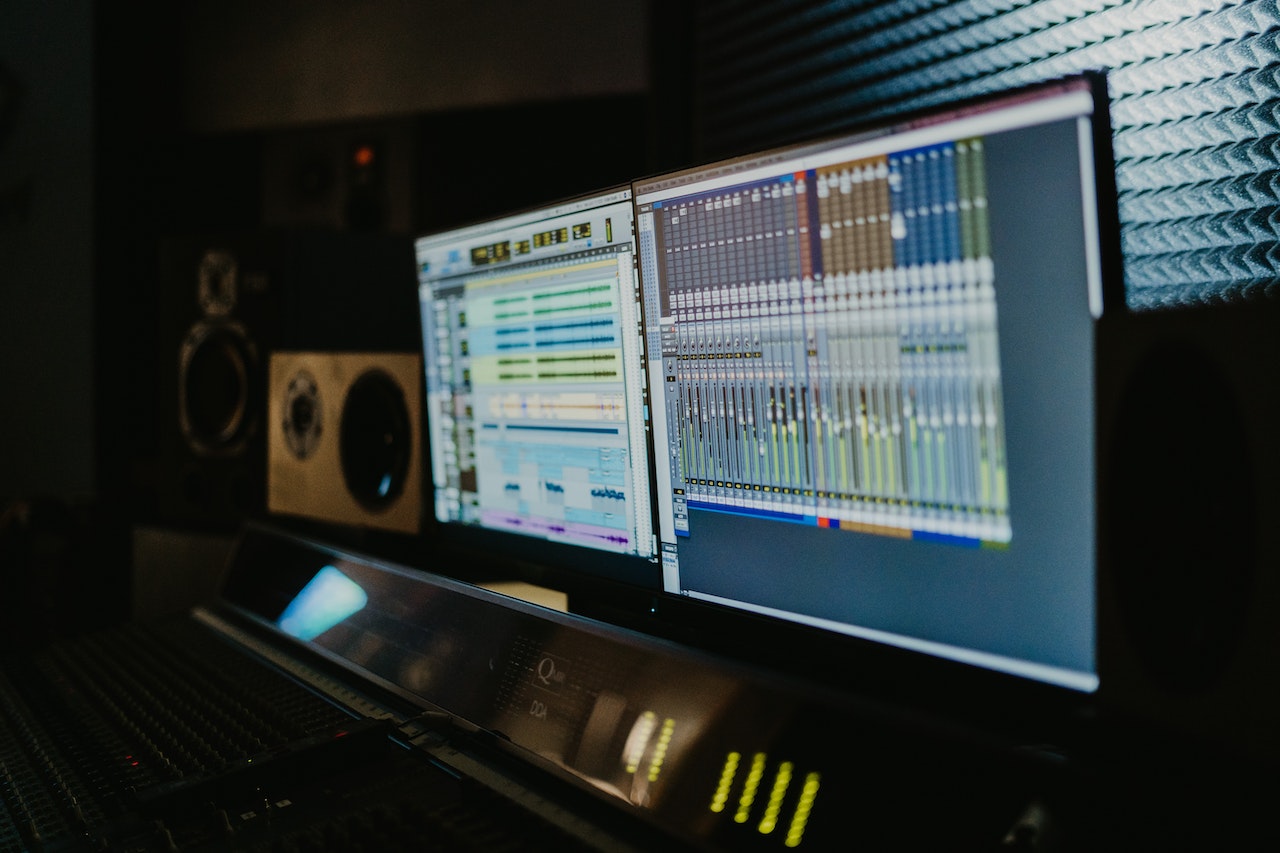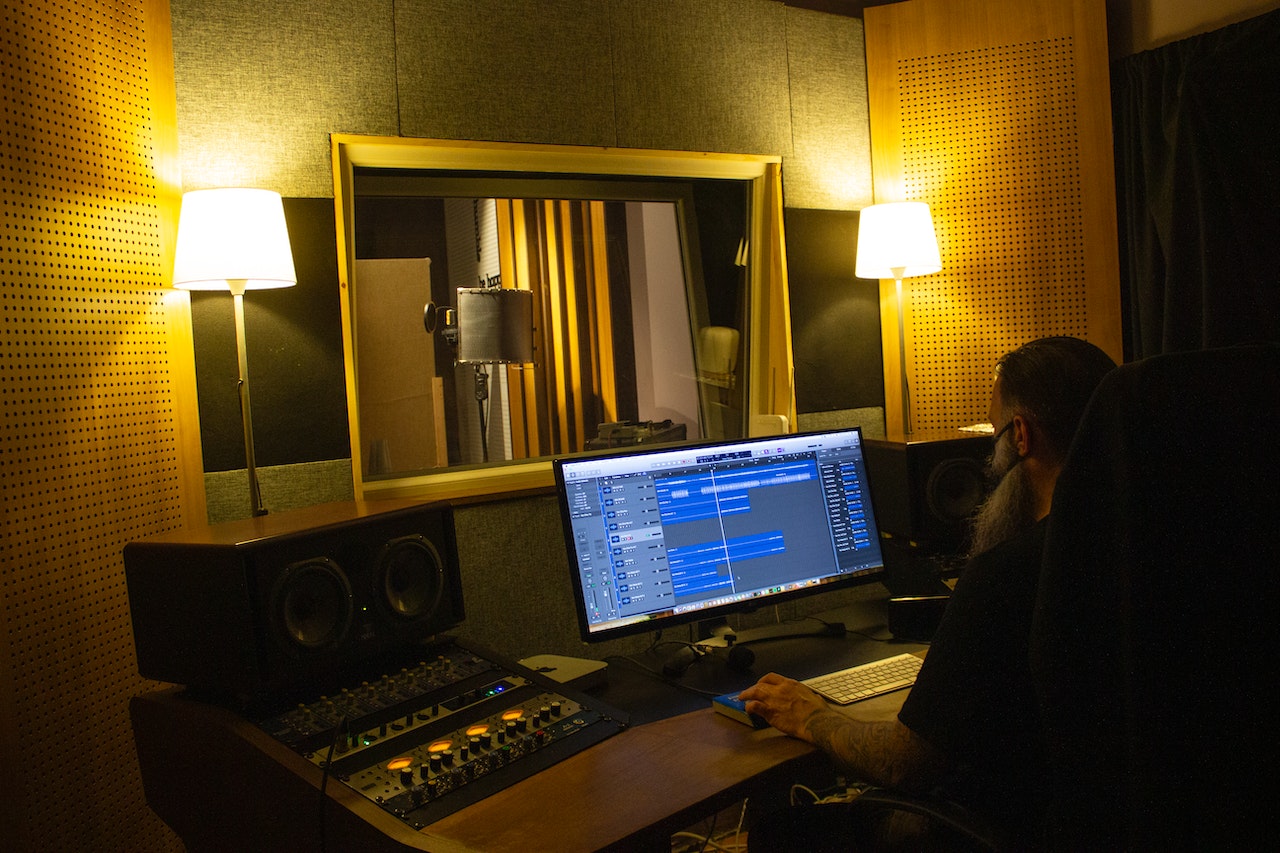If you’ve ever found yourself entwined in the intricate world of podcast production, you’ve likely encountered the term “XLR Outputs.” But what exactly are they, and why should you, an aspiring audio wizard, care about them? Let’s embark on a sonic journey together, exploring the depths of audio interfaces and the pivotal role of XLR outputs in enhancing our audio experiences.
In the realm of podcast production, the significance of a quality audio interface cannot be overstated. It acts as the linchpin in your setup, bridging the gap between the physical world of sound and the digital domain. In case you’re recording a webisode, developing music, or setting up a recreation room, the audio interface you choose can dramatically impact the quality and clarity of your final output.
And, dear reader, fret not! This isn’t just a theoretical journey. Along the way, we’ll also be spotlighting some of the top-notch products available in the market, ensuring that you’re not just armed with knowledge but also guided towards making an informed choice when it comes to selecting the best audio interface with XLR outputs for your specific needs.
So, buckle up as we dive into the melodious world of audio interfaces, exploring, learning, and discovering the best in the business!
Related: Best Podcast Mixers
Contents
A Glimpse Into The XLR Universe
XLR outputs are synonymous with delivering high-quality audio, and they’ve become a staple in professional audio setups across the globe. But why is that? XLR connectors, with their distinctive three pins, are revered for their ability to transmit balanced audio signals.
This means they can minimize noise and interference over long cable runs, ensuring that the sound quality is preserved from source to destination. This is crucial in a myriad of settings, from live concerts to intimate studio recordings, where preserving the authenticity and clarity of sound is paramount.
Moreover, XLR outputs are not just about preserving sound quality. They’re about creating a reliable, stable connection that won’t let you down in the middle of a recording session or live performance. The locking mechanism inherent to XLR connectors prevents accidental disconnections, providing a secure and steadfast link that ensures continuous audio flow.
This reliability, combined with the superior audio quality, makes XLR outputs the go-to choice for audio professionals and enthusiasts alike.
The Pivotal Role Of Audio Interfaces With XLR Outputs
When it comes to connecting your microphones, instruments, or other audio sources to your computer or recording device, an audio interface acts as the gateway. Audio interfaces with XLR outputs bring forth the promise of delivering pristine, uncolored, and noise-free audio, which is especially crucial when high-quality recordings are non-negotiable.
Whether you’re laying down tracks in a studio or amplifying vocals on stage, the interface will ensure that your sound is transmitted clearly and accurately, maintaining the integrity of the original source.
In the context of home studios, podcast setups, or even professional recording environments, audio interfaces with XLR outputs offer a versatile solution to manage various audio sources. They allow you to:
- Ensure Balanced Audio: Minimize the risk of signal degradation and interference, especially over long cable runs.
- Maintain Signal Integrity: Preserve the quality and authenticity of the original audio source, ensuring that the recorded sound is a true representation of the original.
- Provide Scalability: Offer the flexibility to connect multiple devices, ensuring that your setup can grow and adapt to your evolving audio needs.
Stay tuned as we continue to navigate through the fascinating world of audio interfaces and XLR outputs, ensuring that your audio journey is always of the highest fidelity.
6 Best Audio Interface With XLR Output
Without any further ado, let’s dive deeper into our top picks!
1. Focusrite RedNet AM2
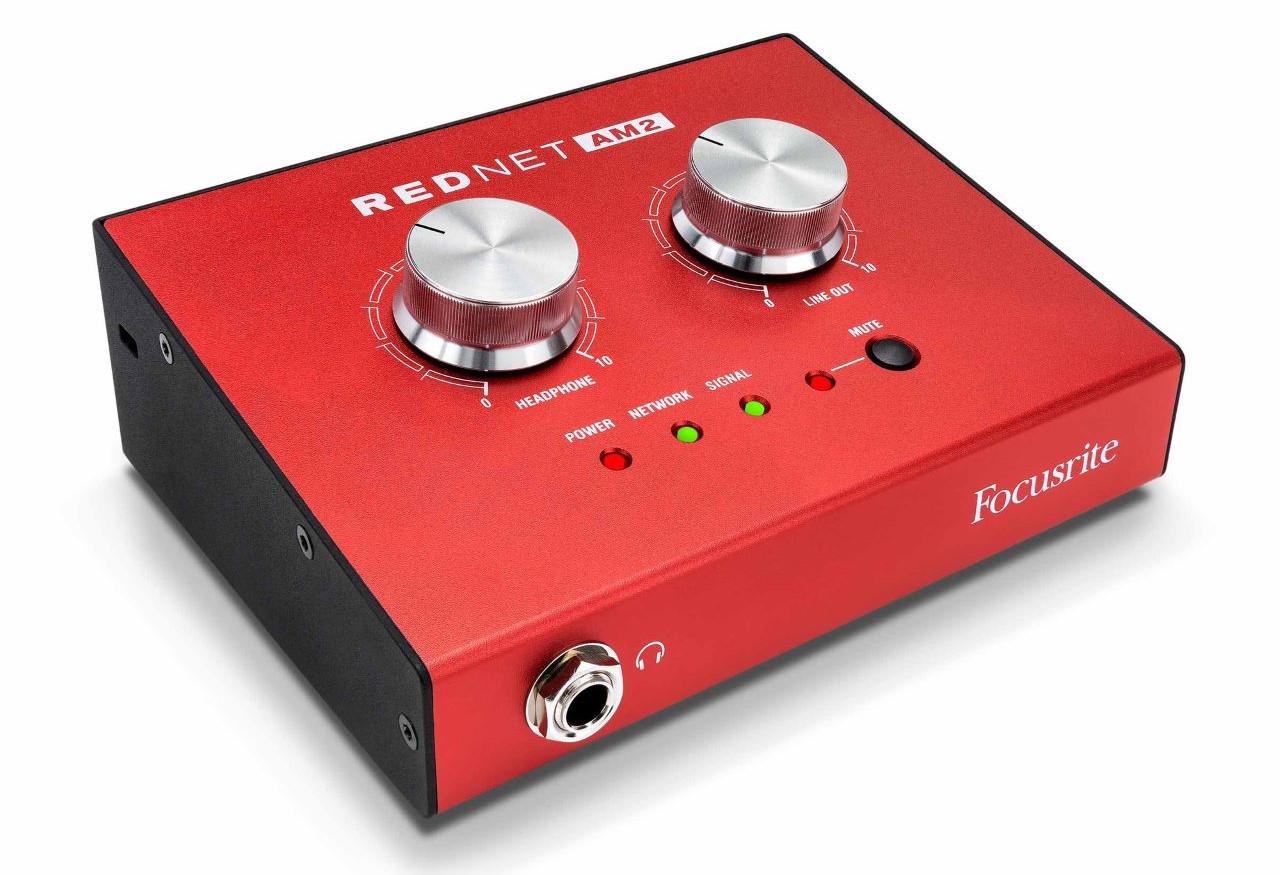
RedNet AM2 includes a 2-channel Dante receiver based around Audinate’s ‘Ultimo’ hardware. Image Source.
Key Features
- Stereo Dante headphone amplifier and line output interface with PoE.
- High-power headphone amp capable of driving both high and low-impedance headphones.
- Superb-quality D/A conversion with standard sample rates from 44.1 to 96kHz.
- Power over Ethernet (PoE) or via an external DC power supply.
- Integrated Gigabit Ethernet switch allows connection of additional network devices.
- ¼” TRS headphone output and dual XLR line-level outputs.
- 2x etherCON network connectors with an integrated network switch.
The Focusrite RedNet AM2 is not just an audio interface; it’s a compact stereo monitoring unit that seamlessly integrates with the Dante audio-over-IP network, providing both headphone outputs and balanced line outputs. This unit is designed to deliver high-quality audio monitoring wherever it’s needed, whether in a studio setup or a live sound environment.
The RedNet AM2 is not only versatile but also offers a solution that is applicable in various settings, including education, live sound, and broadcast, ensuring that your audio monitoring needs are always met with precision and clarity.
Moreover, the RedNet AM2 is equipped with a robust headphone amplifier, designed to drive a wide range of headphones, even those with high impedance up to 600 ohms, at substantial levels. This makes the unit suitable for diverse applications, from on-stage use to studio environments, ensuring that the audio quality is always maintained.
The XLR line-specific outputs also come with a software-modifiable 0dBFS reference level of +18 or +24dBu, providing flexibility and control over your audio output levels.
Pros
- Provides controlling quality precision digital transmutation for Dante networks.
- It offers the capacity to drive uniform high-impedance headphones at substantial levels.
- Independent headphone and line-out level controls for flexible audio management.
- Integrated mute switch for instant signal cut-off to external power amps or speakers.
- Compact and sturdy design with mounting options for mic stands.
Cons
- The price point may be a bit steep for hobbyists or small-scale setups.
- It may offer more features than needed for very simple audio setups.
2. Tascam Series 208i

The Tascam Series 208i has two optical S/MUX expansion ports that accept up to 16 channels of audio input. Image Source.
Key Features
- Four ultra-minimal noise Tascam Ultra HDDA mic preamplifiers.
- 8 ¼-inch linear line outputs for multifaceted monitoring and up to 7.1 enclosed audio.
- Ingrained effects: reverb, four-band EQ, and compressor.
- Powerful 8-bus mixer DSP input/output mixer restrained with free Tascam software.
- Yielding I/O routing: any analog, optical, or USB audio input can be assigned to any output ports.
- Up to 24-bit/192 kHz recording and playback.
- MIDI interface and Word clock in/out.
The Tascam Series 208i is a USB Audio/MIDI Interface that brings professional quality, expandability, and a plethora of effects processing to your recording setup, whether it be in a studio, home, or live recording environment. With a sleek, angled tabletop design and large, easy-to-grab knobs, the 208i sets a new standard for mid-grade audio interfaces, ensuring that your audio recording and production are of the highest quality.
The unit is not only aesthetically pleasing but also functionally robust, offering a range of features that cater to both novice and professional audio engineers and producers.
Moreover, this USB audio interface is equipped with four sub-sonic noise Tascam Ultra HDDA microphone preamplifiers, ensuring that your audio is captured with utmost clarity and precision. The interface also provides dual perceptible S/MUX expansion ports that accept uptill 16 channels of audio input, making it a versatile choice for those looking to record multiple audio sources simultaneously.
With up to 24-bit/192 kHz recording and playback, this best USB audio interface ensures that your audio is captured and reproduced with high fidelity, ensuring that no detail is lost in the process.
Pros
- Provides professional-quality audio recording and playback.
- Expandable input capability, allowing for growth and adaptability in your setup.
- Built-in DSP Effects and Processing, eliminating the need for external effects processors.
- Comes bundled with a range of software, including Steinberg DAW and IK Multimedia effects/modeling.
- Versatile and flexible I/O routing, allowing for a customized setup.
Cons
- Might be over-featured for beginners or those with simpler setups.
- The price may be a barrier for hobbyists or those on a tight budget.
3. Shure ANI22
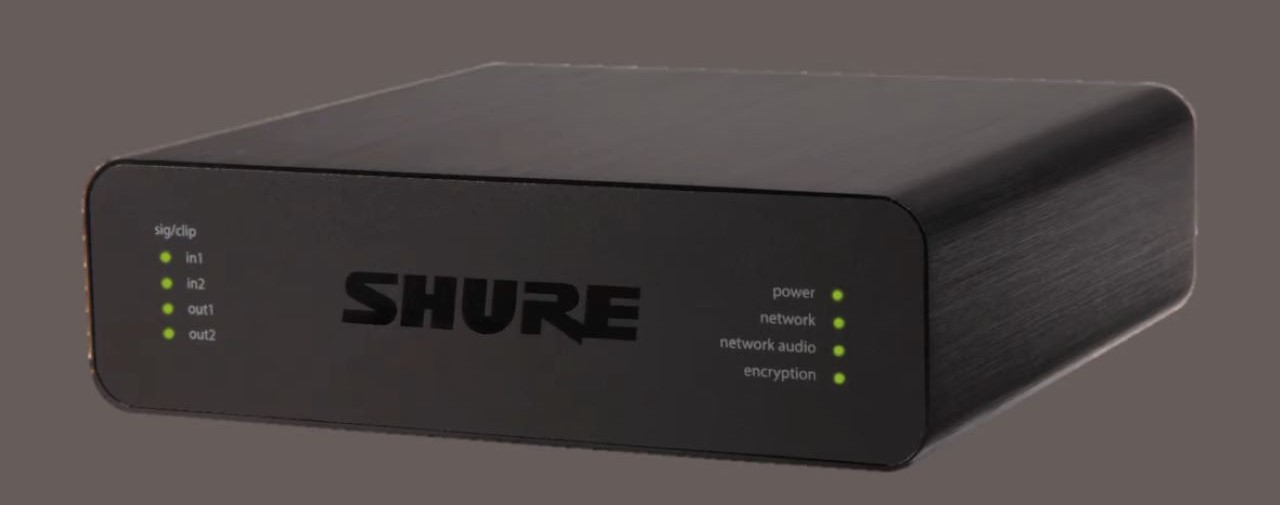
The ANI22 converts up to 2 mic/line analog signals onto a Dante Network. Image Source.
Key Features
- Converts up to 2 line or microphone signals from a Dante network.
- Provides easy audio routing and convenient browser-based remote control.
- Complements the existing ANI4IN and ANI4OUT products.
- Ensures high-quality audio signal management without loss of quality.
- User-friendly and efficient, providing straightforward audio signal conversion.
The Shure ANI22 Audio Interface is a device that stands out for its ability to convert up to 2 line or microphone signals from the same network, as mentioned in one of the key features, ensuring easy audio routing and convenient browser-based remote control. This interface is not only a technological marvel but also a practical tool for audio professionals who require a seamless and efficient way to manage their audio signals.
The ANI22 complements the existing ANI4IN and ANI4OUT products, providing a comprehensive solution for audio network interfacing.
In addition, the ANI22 is designed to be user-friendly and efficient, providing a straightforward solution for converting audio signals without the need for complex setups or configurations. The device is particularly useful in scenarios where precise audio routing and conversion are required, ensuring that the audio signals are managed effectively and without loss of quality.
With its robust build and reliable performance, the ANI22 is a valuable addition to any audio setup, providing a reliable and efficient means of managing audio signals in a networked environment.
Pros
- Efficient and straightforward audio signal conversion.
- High-quality audio management without loss of fidelity.
- User-friendly interface and setup, ensuring ease of use for professionals.
- Reliable performance, ensuring consistent and dependable audio signal conversion.
- Versatile use, applicable in various audio management scenarios.
Cons
- Limited to 2 line or mic signals, which might be restrictive for larger setups.
- May require additional devices (like ANI4IN and ANI4OUT) for comprehensive audio network interfacing.
4. RME ADI-2 Pro SE
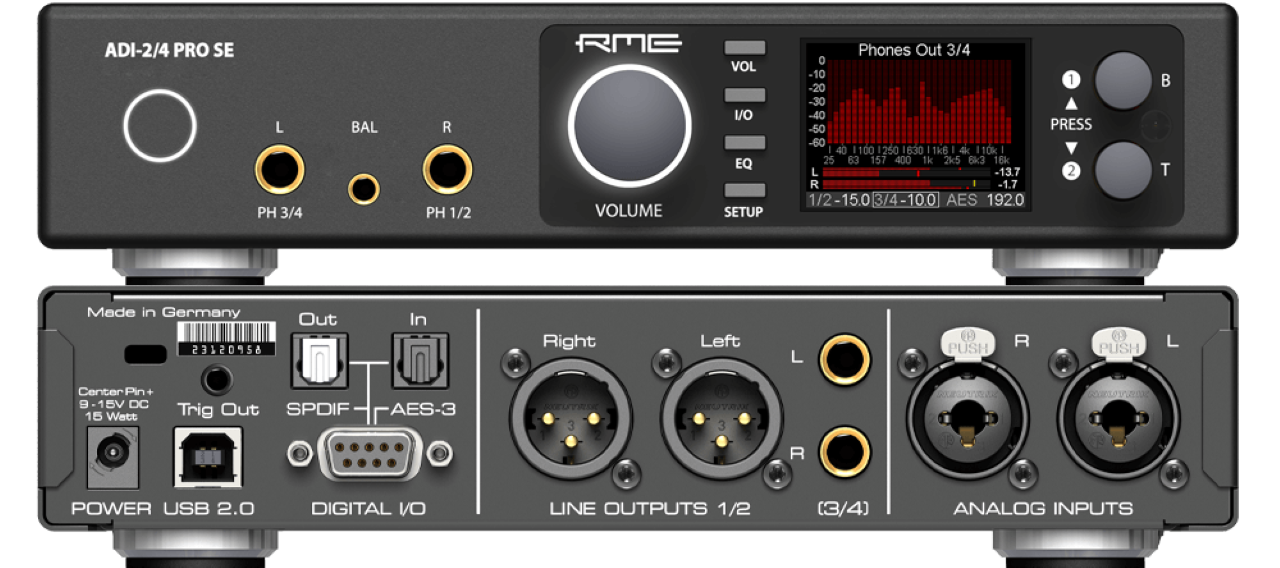
The RME ADI-2 Pro SE is a high-end AD/DA converter in professional studio quality. Image Source.
Key Features
- 2-AD/4-DA 768 kHz high-performance converter.
- Excessive power headphone amplifiers, comprising IEM power setting.
- Super low noise 4.4 mm Pentaconn well-balanced connection.
- RIAA mode for instantly digitizing vinyl discs.
- Comprehensive DC input socket, able to take voltages from 9.5 Volts up to 15 Volts.
- Multi-Remote-Control (MRC) for managing various parameters.
- SteadyClock FS for reference-class digital clocking.
The RME ADI-2 Pro SE emerges as a high-performance converter that operates with an impressive 2-AD/4-DA 768 kHz, ensuring that your audio is managed, converted, and delivered with utmost precision and quality. This device is not merely a converter; it’s a multifaceted tool that brings together a multitude of devices into one compact housing, providing a comprehensive solution for audio professionals who demand the best in audio conversion and management.
With a newly developed circuit board, improved specs, and a faster DSP, it delivers an outstanding transparent sound signature, undue power headphone amplifiers, and a super low noise 4.4 mm Pentaconn symmetrical connection.
Also, the ADI-2 Pro SE is not just about high-quality conversion; it’s about providing a versatile and comprehensive solution for audio management. With features like a trigger-out function for powering on/off peripheral devices and an RIAA method for instantly digitizing vinyl discs at the highest quality, it ensures that your audio is not only converted but also managed and delivered in a way that maintains its quality and integrity.
The device also offers a multitude of I/O options and features, ensuring that it can adapt to various audio setups and requirements, providing a no-compromise approach to audio.
Pros
- Provides high-quality, precise audio conversion with up to 768 kHz.
- Versatile and comprehensive, offering a range of features and options for audio management.
- Capable of digitizing vinyl records with RIAA mode, ensuring high-quality digitization.
- Offers a range of I/O options and features, ensuring adaptability to various setups.
- Comes with a newly developed circuit board and faster DSP for outstanding transparent sound.
Cons
- May be complex for beginners or those unfamiliar with advanced audio management and conversion.
5. Behringer UMC404HD

Behringer UMC404HD has 4×4 USB 2.0 Audio/MIDI Interface for recording microphones and instruments. Image Source.
Key Features
- Equipped with Midas Microphone Preamplifiers for high-quality audio capture.
- Provides connectivity for microphones, guitars, keyboards, and MIDI devices.
- Studio-grade 24-bit/192 kHz converters for the best possible sound quality.
- Versatile and robust, it provides a comprehensive audio solution for various applications.
The Behringer UMC404HD is a music fanatic 4×4, 24-Bit/192 kHz Audio/MIDI Interface that comes primed with Midas Microphone Preamplifiers, ensuring your audio is captured and reproduced with utmost clarity and precision. This interface is not merely a tool for connecting your audio to your computer; it’s a robust, feature-rich device that ensures your audio is managed, converted, and delivered with the highest quality possible.
The UMC404HD is designed to be a bridge between your creativity and your fans, providing all the connectivity required for your microphones, guitars, keyboards, and even MIDI devices.
Furthermore, the UMC404HD is not just about connectivity; it’s about providing a comprehensive, high-quality audio solution that caters to both recording and playback. With studio-grade 24-bit/192 kHz converters, it ensures that your audio is of the best possible sound quality, whether you’re recording a vocal, an instrument, or playing back an audio track.
Whether you’re a singer-songwriter, a producer on the go, or you need a rock-solid interface for running backing tracks at a gig, the ultra-dependable UMC404HD will assist you in glowing in the digital domain.
Related: Best Audio Interface Under 200 Dollars
Pros
- Provides high-quality audio recording and playback with 24-bit/192 kHz resolution.
- Equipped with Midas Mic Preamplifiers, ensuring clear and precise audio capture.
- Versatile connectivity options, catering to various audio sources and devices.
- Robust and reliable, ensuring consistent performance and durability.
- Suitable for various applications, from recording to playback and live performances.
Cons
- May be perceived as complex for beginners or those unfamiliar with audio interfaces.
- The multitude of features and options may be overwhelming for some users.
6. Yamaha Tio1608-D

The Tio1608-D is a Dante-equipped I/O rack with 16 microphone/ line inputs and 8 line outputs. Image Source.
Key Features
- Dante-equipped I/O rack with 16 microphone/line inputs and 8 line outputs.
- Recallable D-PRE™ microphone preamplifiers ensuring high-quality audio capture.
- Plug-and-play Dante stage box solution, ensuring easy setup and management.
- Compatible with TF series consoles, allowing for easy and efficient integration.
- Provides a comprehensive solution for managing audio in a networked environment.
The Yamaha Tio1608-D is a Dante-equipped I/O rack that brings to the table 16 microphone/line inputs and 8-line outputs, providing a robust and versatile solution for managing your audio in a networked environment. This device is not just an I/O rack; it’s a comprehensive audio management solution that ensures your audio is captured, converted, and transmitted with the highest quality possible.
The Tio1608-D is designed to be a plug-and-play Dante stage box solution, providing easy and efficient audio management in various setups, whether it be live performances, recording sessions, or other professional audio applications.
The Tio1608-D is not just about providing inputs and outputs; it’s about ensuring that your audio is managed effectively and efficiently, providing a seamless audio experience that maintains the integrity and quality of the audio signal throughout the signal path.
With the same recallable D-PRE™ microphone preamplifiers as the TF series, it delivers remarkably natural and orchestral sound, ensuring that your audio is not only captured but also reproduced with the utmost fidelity and clarity. Whether you’re working in a studio, performing live, or managing audio in other professional scenarios, the Tio1608-D provides a reliable and high-quality solution for your audio needs.
Pros
- Provides a robust and versatile solution for managing audio in various setups.
- Ensures high-quality audio capture and reproduction with D-PRE™ microphone preamplifiers.
- Easy and efficient setup and management with a plug-and-play Dante stagebox solution.
- Compatible with various Yamaha digital mixing consoles, ensuring versatile application.
- Reliable and efficient, ensuring consistent performance in various applications.
Cons
- May require additional setup or configuration for integration into existing systems.
- Might be perceived as complex or over-featured for smaller or simpler audio setups.
Navigating Through The Choices Of XLR-Equipped Audio Interfaces
Let’s delve into the intricate world of XLR-equipped audio interfaces, exploring the nuances and unraveling the mysteries that will guide you to your ideal selection.
Ensuring Compatibility And Seamless Connectivity
Navigating through the myriad of options available in the market for audio interfaces, especially those equipped with XLR outputs, can be a daunting task. Ensuring compatibility and seamless connectivity between your audio devices, computers, and the interface itself is paramount.
The harmony between hardware and software, physical connections, and the interface’s features can significantly impact the quality and efficiency of your audio production and management.
Evaluating Computer and Interface Connections
When it comes to ensuring a smooth connection between your computer and the audio interface, it’s crucial to consider the types of connections they support. USB, Thunderbolt, and FireWire are common types of connections found in audio interfaces. Each comes with its own set of advantages and potential limitations.
USB is widely used and is compatible with most USB interface systems, while Thunderbolt offers higher data transfer rates and lower latency. Ensure that your computer has the necessary ports and that the interface you choose supports your preferred connection type.
Aligning With Software And Operating Systems
The compatibility between your audio interface and your operating system and software is crucial to ensure a smooth workflow. Ensure that the interface you choose supports your OS, whether it be Windows, macOS, or another system.
Additionally, consider the Digital Audio Workstation (DAW) you’ll be using and check for compatibility and easy integration with the interface. Some USB audio interfaces come with bundled software or DAWs, which can be a boon for beginners or those looking to expand their software arsenal.
Addressing Physical Connection Needs
Physical connections pertain to the inputs and outputs of the audio interface. Consider the number of XLR inputs and outputs, line inputs, instrument inputs, and any additional I/O that you may require for your setup.
Ensure that the interface can accommodate all your gear, from microphones to instruments, and consider future expandability. Also, ponder upon the form factor and build quality of the interface, ensuring it suits your workspace and usage conditions.
Offering Brand And Model Suggestions

Image by Freepik
In the vast universe of audio interfaces, brands and models stand out as celestial bodies, each shining with its own unique light and characteristics. The selection of a brand or model is often influenced by a myriad of factors, including personal preference, specific feature requirements, budget constraints, and, sometimes, brand loyalty developed through positive past experiences.
As we delve into the cosmos of brands and models, it’s pivotal to consider not just the technical specifications but also the support, reliability, and overall user experience that they offer. From budget-friendly options that cater to beginners and hobbyists to high-end models that professional studios swear by, let’s navigate through the suggestions that cater to various needs and budget ranges.
Catering to Various Budget Ranges
From entry-level to professional-grade, the market is flooded with options that cater to various budget ranges. For beginners or those on a tight budget, brands like Behringer and Focusrite offer reliable and quality options. Mid-range options might include Tascam and Yamaha, while high-end professional interfaces may be sourced from brands like RME and Universal Audio.
Navigating Through Popular Brands
Popular brands like Focusrite, Behringer, and Yamaha are renowned for their reliability, quality, and customer support. RME, although pricier, is celebrated for its premium quality and professional-grade features. Each brand offers a unique set of features, aesthetics, and pricing, ensuring that there’s something for everyone, from beginners to seasoned professionals.
Providing Resources For Further Research
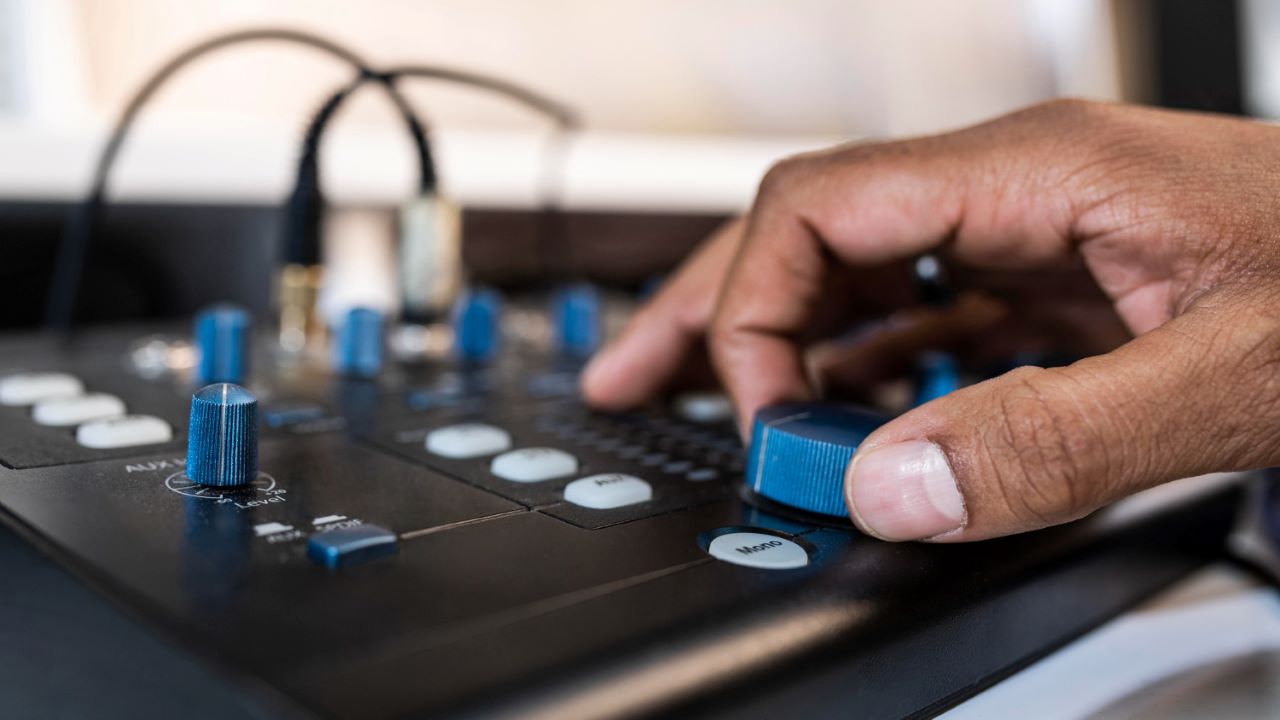
Image by Freepik
Embarking on the journey to select an audio interface is not a solo endeavor. The internet is teeming with resources, platforms, and communities that provide valuable insights, reviews, and experiences that can guide your selection process. From expert reviews that delve into the nitty-gritty of technical specifications to forums where users share their real-world experiences and challenges, these resources can be a goldmine of information.
As we explore these platforms, it’s crucial to approach information with a discerning eye, recognizing that while expert reviews provide a professional perspective, user experiences can offer insights into the practicalities and potential challenges of using the interface in everyday scenarios.
Review Platforms and Forums
Platforms like Gearslutz, Sound on Sound, and various audio production forums provide a wealth of information, reviews, and user experiences that can guide your purchase decision. Engaging in forums and reading through user reviews can provide real-world insights into the performance, reliability, and potential issues of various interfaces.
Expert Reviews and Comparisons
Expert reviews and comparisons, available on platforms like YouTube, audio tech websites, and magazines, provide in-depth insights and detailed analyses of various audio interfaces. These resources often compare interfaces, providing a comprehensive overview of their features, performance, and value for money, aiding you in making an informed decision.
Deciphering Technical Specifications Of Audio Interfaces
Diving into the technical aspects of audio interfaces, it’s pivotal to comprehend the specifications that each model presents. From understanding bit depth and sample rates to recognizing the importance of preamp quality and I/O capabilities, each specification plays a crucial role in determining the interface’s performance, quality, and suitability for your specific needs.
Ensuring that the technical specifications align with your recording, production, and playback requirements is paramount in selecting an interface that will serve you effectively and efficiently.
Understanding The Impact Of Build Quality And Design
The physical build and design of an audio interface are often overshadowed by its technical capabilities. However, the durability, form factor, and layout of an interface play a pivotal role in its usability, longevity, and overall user experience.
From the quality of the knobs and connectors to the layout of the controls and the sturdiness of the build, every physical aspect contributes to the interface’s performance and reliability in various usage scenarios, whether it be in a controlled studio environment or on-the-go recordings in dynamic settings.
Related: Best Multi USB Microphone Mixer
FAQs
Do All Audio Interfaces Have XLR Inputs?
Not all audio interfaces come equipped with XLR inputs. The inclusion of XLR inputs largely depends on the design, purpose, and target audience of the interface.
- Variety in Design: Audio interfaces are designed to cater to a wide array of users, from podcasters and solo musicians to professional recording studios. Therefore, the type and number of inputs and outputs can vary significantly across different models and brands.
- Purpose-Driven Features: Some interfaces might prioritize other forms of connectivity, such as ¼ inch jack or USB inputs, especially if they are designed for specific applications like connecting instruments directly or mobile recording.
- Size and Portability: Compact and portable interfaces, especially those designed for on-the-go recording or minimal setups, might omit XLR inputs to save space and provide simplicity.
- Budget Constraints: Entry-level or budget-friendly interfaces might offer limited connectivity options, sometimes excluding XLR inputs to keep the cost down.
What Does An XLR Audio Interface Do?
An XLR audio interface serves as a pivotal bridge between your microphones or other audio gear and your computer, ensuring that the audio is transmitted, converted, and processed effectively and with high quality.
- Transmitting Audio: It facilitates the transmission of audio signals from your microphone or other audio sources to your computer or recording device.
- Analog to Digital Conversion: The interface converts the analog audio signals captured by the microphone into digital data that can be processed, recorded, and edited by your computer.
- Quality Preservation: By providing a balanced connection, XLR interfaces help to preserve the quality of the audio signal and minimize interference and noise.
- Versatile Connectivity: It allows users to connect various audio gear, such as microphones, instruments, and studio monitors, providing a hub for managing and routing audio signals.
Do You Need An XLR Cable For The Audio Interface?
If your audio interface and microphone both have XLR connectivity, utilizing an XLR cable is typically the preferred method due to several key reasons:
- Balanced Audio: XLR cables provide a balanced connection, which reduces the risk of interference and noise in the audio signal, especially over longer cable lengths.
- Secure Connection: XLR connectors usually lock into place, ensuring a secure and stable connection that won’t accidentally disconnect during recording or performance.
- Professional Standard: XLR is widely recognized as a professional standard in audio connectivity, providing reliable and high-quality signal transmission.
However, the necessity of an XLR cable ultimately depends on the available connections on your gear and the interface.
Do You Need An Audio Interface Or XLR To USB?
The choice between an audio interface and an XLR to USB cable largely depends on your specific needs, budget, and the scope of your audio projects:
- Audio Interface: Ideal for those who require multiple inputs/outputs, high-quality preamps, and additional features like phantom power, direct monitoring, and more control over the audio signal.
- XLR to USB: A suitable choice for simpler setups, such as single microphone recording, where budget, ease of use, and portability might be prioritized over additional features and connectivity options.
Conclusion
Navigating through the intricate world of audio interfaces, especially those adorned with XLR outputs, can be a journey filled with technicalities, considerations, and a plethora of options. From understanding the fundamental role of an XLR audio interface in transmitting, converting, and preserving audio quality to exploring the diverse array of products available, such as the robust Focusrite RedNet AM2 and the versatile Tascam Series 208i, this guide has aimed to illuminate the path for audio enthusiasts and professionals alike.
While each product spotlighted brings its own unique offerings to the table, the RME ADI-2 Pro SE stands out for its premium quality, professional-grade features, and the sheer precision and clarity it brings to audio conversion and management.
In case you’re embarking on your first audio recording journey or seeking to upgrade your existing setup, may your chosen interface serve as a reliable and quality companion in all your audio endeavors.

